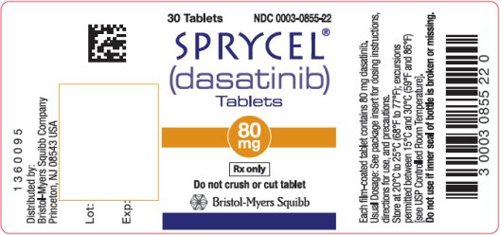How lack of data may have cost a pharmaceutical giant billions
By Rachel Von Hossle onWith 2015 sales of US$1.6Bn and 2017 projected sales of US$2Bn, Bristol-Myers Squibb's (BMS') anti-cancer drug dasatinib (Sprycel®) is highly successful and of great interest to competitors. A February 2017 decision from a Technical Board of Appeal at the EPO (European Patent Office) has resulted in the patent covering dasatinib being revoked. But why?

A brief background
European patent 1169038 [1] covering dasatinib was granted in 2012, opposed in 2013, revoked in January 2016, and the revocation upheld in an appeal decision in February 2017. The case came down to whether the patent application as filed made a plausible and credible disclosure of the claimed invention (i.e. of the technical effect which underpinned the non-obviousness of the claimed invention).
What makes this case particularly interesting?
Three key reasons:
- During the course of opposition and appeal proceedings, the claims of the patent were narrowed down to a single compound (dasatinib);
- The application as filed included statements that experiments had been done and that the activity of the compounds of the invention (i.e. including dasatinib) had been established; and
- The activity of dasatinib was established in later publications which were introduced into proceedings,
However, the application as filed did not contain any actual experimental results backing up those statements as to activity (despite the fact that, apparently, BMS had data available).
A stark warning for the importance of including experimental data in applications
As discussed below, this lack of experimental results in the application as filed caused the patent to be revoked.
The end result is that we now have confirmation of a clear scenario where patent applications are likely to be found lacking plausibility and credibility, i.e. not to be patentable.
This has a significant impact on patentees and opponents, and affects patent drafting and prosecution practice, as well as opposition/litigation practice. Pending patent applications and granted patents are affected - applicants and their counsel are advised to carefully review their patent portfolios to identify cases at risk.
Has the plausibility bar been raised? Arguably not - as detailed below, the Opposition Division relied upon established case law, and the Technical Board of Appeal refused to refer questions to the Enlarged Board of Appeal. However, the outcome of the case acts as a somewhat stark warning to patentees of the dangers of not including experimental results/data in applications as filed.
The opposition and appeal proceedings
Notices of opposition against the granted patent were filed by four parties, including Apotex, Actavis and Mylan (Generics [UK]). During the course of the opposition proceedings, the claims of the patent were narrowed down to a single compound (and salts thereof), with BMS' final Auxiliary Request comprising a single claim directed to a single compound (and salts thereof).
The patent application as filed disclosed hundreds of compounds, and stated that "The compounds of the present invention inhibit protein tyrosine kinases" and that they were "thus useful in the treatment, including prevention and therapy, of protein tyrosine kinase-associated disorders such as immunologic and oncologic disorders". One of the compounds disclosed (Example 455) was dasatinib, although it was not specifically picked out or identified as being particularly advantageous.
The patent application stated that various assays could be used to determine the degree of activity of the compounds as PTK (protein tyrosine kinase) inhibitors, detailed various assays, and stated that:
"Compounds described in the following Examples have been tested in one or more of these assays, and have shown activity."
However, no experimental results were included in the patent application.
Plausibility
The opposition (and the subsequent appeal) was decided on one issue - plausibility. This manifested itself as a "sufficiency of disclosure" (Article 83 EPC) attack against "second medical use" format claims. For the claim directed to dasatinib per se (and not to any medical use of it), this manifested as an inventive step (Article 56 EPC) attack. The end result was the same in both cases, with the claims failing.
As stated in the opposition decision, the key issue was that "the patent application as filed contained no data or evidence to demonstrate that the claimed compounds indeed showed the alleged activity and were thus suitable for the claimed purpose."
Although the claims directed to dasatinib per se did not define a "purpose", in order for the compound to be inventive it needed to be something more than an alternative chemical compound (which lacked inventiveness). Thus, the PTK inhibiting activity had to be plausible.
In their decision, the opposition division relied heavily upon earlier case law (T 609/02 [2] for the "second medical use" claims, stating that:
"In paragraphs 8. and 9. of the reasons for the decision [T 0609/02], the board stressed that sufficiency of disclosure must be satisfied at the effective date of the patent, "i.e. on the basis of the information in the patent application together with the common general knowledge then available to the skilled person". It also stated that it was not always necessary to provide results of clinical trials or involving animals. However, this did not mean that a simple verbal statement in a patent specification that compound X might be used to treat disease Y was enough to ensure sufficiency of disclosure in relation to a claim to a pharmaceutical and found that it was required that the patent provided some information "in the form of, for example, experimental tests, to the avail that the claimed compound has a direct effect on a metabolic mechanism specifically involved in the disease, this mechanism being either known from the prior art or demonstrated in the patent per se. Showing a pharmaceutical effect in vitro may be sufficient if for the skilled person this observed effect directly and unambiguously reflects such a therapeutic application". Only once this evidence was available from the patent application could the post-published evidence be taken into account, but only to back up the findings in the patent application and not to establish sufficiency of disclosure on their own.
"The board came to the conclusion (see paragraph 13. Of the reasons for the decision) that if the description of the patent specification provided no more than a vague indication of a possible medical use for a chemical compound yet to be identified, later more detailed evidence could not be used to remedy the functional insufficiency of disclosure of such subject-matter."
Similarly, for the "product" claim they relied upon T 1329/04 [3] and stated that:
"in a situation … where it was not made plausible on filing that the problem formulated is credibly solved, post-published evidence cannot be taken into account as the sole experimental evidence for establishing an inventive step"
Notably, T 1329/04 states that:
"The definition of an invention as being a contribution to the art, i.e. as solving a technical problem and not merely putting forward one requires that it is at least made plausible by the disclosure in the application that its teaching solves indeed the problem it purports to solve."
The Technical Board of Appeal upheld the earlier opposition decision, and the written decision was notably brief, not referencing any case law or going into detailed reasoning. Notably, they refused to refer questions to the Enlarged Board of Appeal.
What can we learn from BMS’ mistakes?
This case gives us confirmation of earlier EPO case law, and in particular reaffirms that:
- Sufficiency of disclosure must be satisfied at the effective date of the patent, i.e. on the basis of the information in the patent application together with the common general knowledge then available to the skilled person.
- A simple verbal statement in a patent specification that compound X might be used to treat disease Y is not enough to ensure sufficiency of disclosure.
- To establish sufficiency, include Information in the form of, for example, experimental tests, e.g. showing that the claimed compound has a direct effect on a metabolic mechanism specifically involved in the disease, this mechanism being either known from the prior art or demonstrated in the patent per se.
- Showing a pharmaceutical effect in vitro may be sufficient if for the skilled person this observed effect directly and unambiguously reflects such a therapeutic application.
- Later more detailed evidence cannot be used to remedy a functional insufficiency of disclosure in a patent application as filed.
Key Takeaways
- For patent applications in the pharmaceutical field, make sure that the application as filed includes as much verifiable evidence as possible. For applicants cautious about how much data they disclose, seek advice from your attorney about what you might be able to do to establish sufficiency (e.g. including limited data), and the risks involved.
- For high value pharmaceutical patent applications where there is an identified risk in view of this decision, consider filing national patent offices in parallel with an EPO application.
- For opponents (particularly in the pharmaceuticals sector), carefully review the patents you are opposing with a view to plausibility - this could provide a good way to attack patents. Older patents (filed before the current case law issued) may be particularly vulnerable. Look out for evidence filed on patent applications to support technical effects/plausibility - is the application as filed insufficient? Does it establish plausibility?
- Although this decision issued on a pharmaceutical case, the same "plausibility" issue applies to patents in other technical sectors
Useful Links
[2] https://www.epo.org/law-practice/case-law-appeals/recent/t020609eu1.html
[3] https://www.epo.org/law-practice/case-law-appeals/recent/t041329eu1.html
